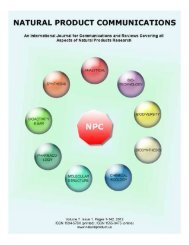This Issue is Dedicated to the Memory of Professor Ivano Morelli
This Issue is Dedicated to the Memory of Professor Ivano Morelli
This Issue is Dedicated to the Memory of Professor Ivano Morelli
Create successful ePaper yourself
Turn your PDF publications into a flip-book with our unique Google optimized e-Paper software.
1108 Natural Product Communications Vol. 1 (12) 2006 Hamburger et al.<br />
<strong>the</strong> identification <strong>of</strong> a variety <strong>of</strong> bioactive compounds<br />
from I. tinc<strong>to</strong>ria [5, 7, 8] and o<strong>the</strong>r plants [17].<br />
For HPLC pr<strong>of</strong>iling, <strong>the</strong> SFE extract was d<strong>is</strong>solved in<br />
dichloromethane (10 mg/mL) and separated on an<br />
analytical C-18 column. Aliquots <strong>of</strong> 200 μg extract<br />
per injection were repeatedly fractionated. A linear<br />
gradient from 10% <strong>to</strong> 100% ace<strong>to</strong>nitrile over 25 min<br />
was followed by <strong>is</strong>ocratic elution for an additional 20<br />
min. In a first pr<strong>of</strong>iling step, 15 fractions <strong>of</strong> 3 min<br />
each (Fr. 1-15) were collected. The solvent was<br />
removed in an evapora<strong>to</strong>r centrifuge and <strong>the</strong> dry<br />
films were red<strong>is</strong>solved in 180 µL DMSO for <strong>the</strong><br />
elastase assay, which was carried out according <strong>to</strong> a<br />
publ<strong>is</strong>hed pro<strong>to</strong>col [16], whereby p-nitro-aniline<br />
release was quantified by measurements <strong>of</strong><br />
absorbancy at 405 nm. Representative HPLC<br />
chroma<strong>to</strong>grams recorded at 254 and 220 nm and <strong>the</strong><br />
activity pr<strong>of</strong>ile <strong>of</strong> fractions 1 <strong>to</strong> 15 in <strong>the</strong> elastase<br />
assay are shown in Figure 1.<br />
Figure 1: HPLC chroma<strong>to</strong>gram <strong>of</strong> Isat<strong>is</strong> tinc<strong>to</strong>ria extract recorded at 220<br />
nm (bot<strong>to</strong>m). Vertical lines indicate time windows for fractions 1 <strong>to</strong> 15.<br />
Inhibi<strong>to</strong>ry activity <strong>of</strong> fractions <strong>is</strong> shown above (mean <strong>of</strong> 3 independent<br />
experiments in two parallels).<br />
Inhibi<strong>to</strong>ry activities > 50% were found in fractions 8<br />
(77%), 9 (66%), 14 (78%) and 15 (85%). In a second<br />
step, fractions <strong>of</strong> 0.5 min were collected in <strong>the</strong> time<br />
window 21 <strong>to</strong> 30 mins, which corresponded <strong>to</strong><br />
fractions 8 <strong>to</strong> 10. The HPLC pr<strong>of</strong>ile <strong>of</strong> th<strong>is</strong> time<br />
window and fractionation steps (8-1 <strong>to</strong> 10-6) are<br />
shown in Figure 2.<br />
Fractions were analyzed by HPTLC (RP-18,<br />
HOAc/H 2 O (95:5)). Upon staining with Godin’s<br />
reagent, fractions 8-5, 9-2, 9-5 and 9-6 each showed<br />
one single violet spot in <strong>the</strong> R f range 0.4 <strong>to</strong> 0.5. The<br />
Figure 2: HPLC chroma<strong>to</strong>gram recorded at 220 nm <strong>of</strong> <strong>the</strong> time window<br />
from 21 <strong>to</strong> 30 min, corresponding <strong>to</strong> fractions 8-1 <strong>to</strong> 10-6. Vertical lines<br />
indicate time windows for fractionation.<br />
R f values were comparable with α-linolenic, linoleic<br />
and oleic acids. For fur<strong>the</strong>r analys<strong>is</strong>, fractions 8-1 <strong>to</strong><br />
10-6 were submitted <strong>to</strong> GC after derivatization with<br />
TMSH. The results <strong>of</strong> <strong>the</strong> fatty acid analys<strong>is</strong> <strong>of</strong> <strong>the</strong><br />
major fractions 8-5, 9-2, 9-5 and 9-6 are shown in<br />
Figure 3. Identification was carried out by an overlay<br />
<strong>of</strong> GC chroma<strong>to</strong>grams with a standard reference mix<br />
(C-18 FAME Isomer Mix, Supelco). Fraction 8-5<br />
cons<strong>is</strong>ted <strong>of</strong> α-linolenic acid, fraction 9-2 <strong>of</strong> linoleic<br />
acid, whereas fraction 9-5 contained oleic acid and<br />
c<strong>is</strong>-11-octadecenoic acid in equal proportions.<br />
Fraction 9-6 cons<strong>is</strong>ted <strong>of</strong> palmitic acid.<br />
Inhibition <strong>of</strong> human neutrophil elastase by saturated<br />
and unsaturated fatty acids has been recently<br />
reported. The IC 50 <strong>of</strong> α-linolenic, linoleic, oleic and<br />
palmitic acids were in <strong>the</strong> range <strong>of</strong> 5 <strong>to</strong> 15 µM [18].<br />
Hence, inhibi<strong>to</strong>ry activity in fractions 8 and 9 can be<br />
attributed <strong>to</strong> <strong>the</strong>se fatty acids. HPTLC and GC<br />
analys<strong>is</strong> <strong>of</strong> fractions 14 and 15, however, showed that<br />
<strong>the</strong>y contained only traces <strong>of</strong> fatty acids. Elastase<br />
inhibition in <strong>the</strong>se fractions seems thus due <strong>to</strong> highly<br />
lipophilic compounds, which remain <strong>to</strong> be identified.<br />
Experimental<br />
Organic solvents for separations were HPLC grade<br />
(Roth, Karlsruhe, Germany). HPLC grade water was<br />
obtained from a Milli-Q RG water purification<br />
system (Millipore, Schwalbach, Germany).<br />
Leaf material <strong>of</strong> I. tinc<strong>to</strong>ria was harvested in 2001<br />
from first year plants grown on experimental plots <strong>of</strong><br />
<strong>the</strong> Agricultural Research Station <strong>of</strong> Thuringia<br />
(TLL), Dornburg, Germany. Fresh leaves were dried<br />
on a band drier operating at 60ºC.







